Sign In
Welcome to AI Checker Sign in to continue your exploration of our platform with all its exciting features.
Forgot Password?
Don’t have an account ? Sign Up
Forgot Password
We'll Send You An Email To Reset Your Password.
Back to Login
Sign Up
Embrace the Future with AI Checker Sign up now and let's rewrite the possibilities together.
Already have an account? Sign In
Enter OTP
We'll send you an email to reset your password.
Back to Login
Enter OTP
We'll send you an OTP on your registered email address.
Back to Login
Confirm Password
Please enter your new password.
How to Avoid Google Penalties by Humanizing Your AI Content
 Nathan Porter
Nathan Porter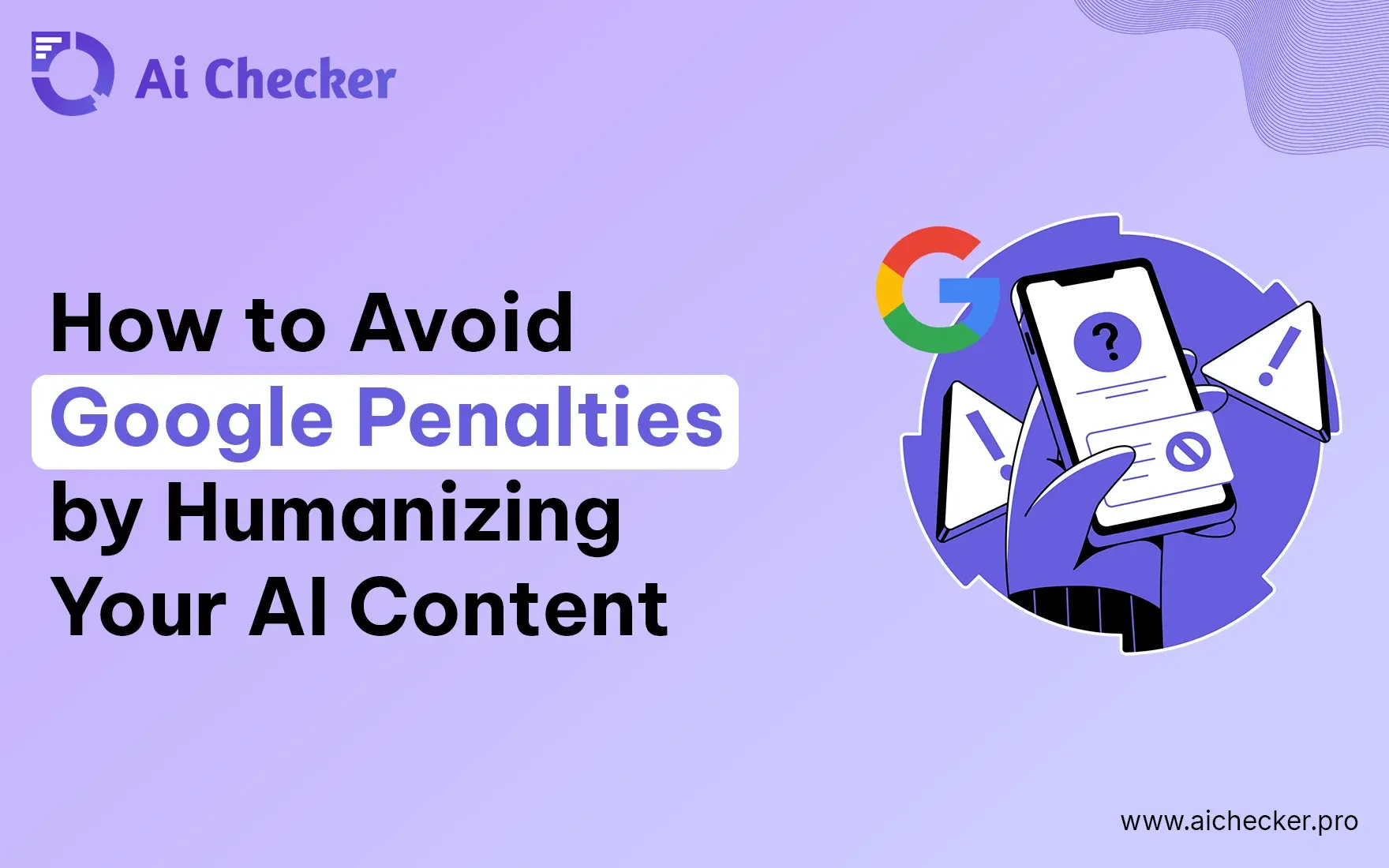
TABLE OF CONTENTS
Quick Summary
What is AI-generated Content?
Why Should You Humanize AI Content?
What Are the Risks of Using AI Content Without Humanization?
How to Avoid Google Penalties for AI Content
Best Practices for Humanizing AI Content
Tools and Services to Help Humanize AI Content
Case Study: AI Content Penalty & Recovery
Final Checklist: Before Publishing Your AI-Generated Content
Conclusion
FAQs
AI writing tools have transformed the way we create content. Many bloggers, SEO experts, and content writers are creating content faster than ever with AI-generated articles. The problem? Google has gotten more sophisticated in recognizing AI-written content.
First, if you're using AI tools like ChatGPT, Jasper, or Copy.ai and don't properly humanize the piece of content, you might be jeopardizing your web search rankings. Google algorithm penalties could seriously ruin your website; the process could destroy months of hard work in a matter of days.
So, do you have to stop using AI tools altogether? Nope! You just need to know how to properly humanize your AI content. This guide will show you how to do this, step by step.
No matter if you're a brand-new beginning blogger or you've been doing SEO forever, this article will help you create AI content that ranks well on Google and engages your audience.
Quick Summary
In this guide, you will find out what AI-generated content is and why Google cares. The major reasons to humanize AI content and the real dangers of publicly displaying raw AI content without edits. The established approaches to evade Google penalties, and the best practices that actually work for humanizing. What tools are worthwhile in the process, a real case study demonstrating penalty and recovery, and a final checklist before going live?
If you are on a time crunch, focus on the "Best practices for humanizing AI content" section. This section will be the most easily actionable tips for immediate use.
What is AI-generated Content?
AI-generated content means text, images, or other media created by artificial intelligence systems. The AI systems employ algorithms and machine learning models to make content. It becomes similar to human writing style. It is very quick and inexpensive to produce such content.
The best examples of AI content creation are tools such as ChatGPT or Jasper AI. With these AI, you can have content in seconds. An easy option for users, but AI content tends to lack quality, depth, and feelings that humans want. This is whys there is a need for humanization.
Can Google detect AI content? Yes, it can and increasingly so.
Why Should You Humanize AI Content?
Humanizing AI content means making it sound more like you, with your own voice, experiences, and perspectives to sound more human, natural, and engaging, and here's why this is so important for a content strategy.
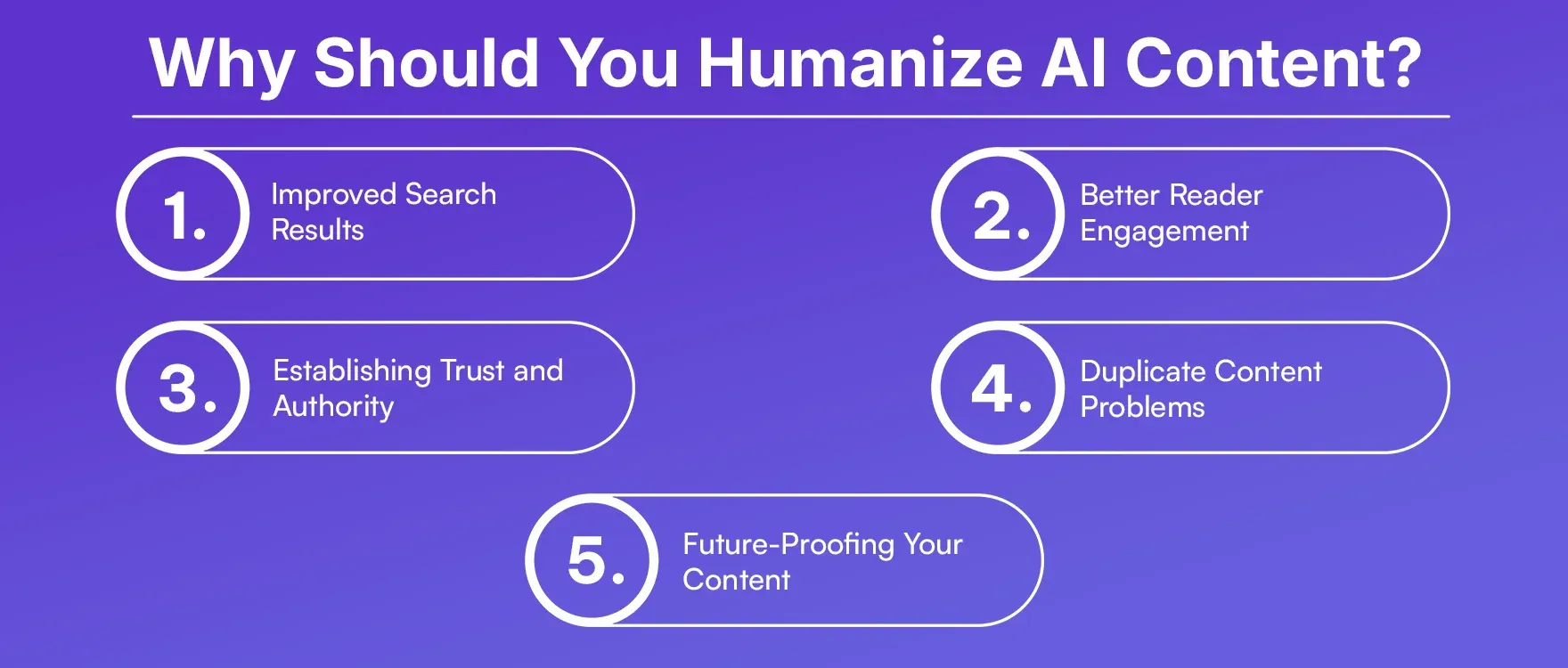
1. Improved Search Results
Google's algorithm loves content that offers real value and benefit to users. Humanizing AI content makes it much more valuable and beneficial, resulting in improved search rankings. Search engines can tell when AI text is just generic text compared to text created from real expertise and experience. Google patents AI search 2025 have reinforced this approach.
2. Better Reader Engagement
Human-like content helps keep readers on your page longer. They like the content and connect better with stories, experiences, and content that has a conversational writing style instead of AI-generated robotic text. Longer time spent on your content signals to Google that your content is valuable.
3. Establishing Trust and Authority
When you introduce your experience and insights, a reader is more likely to view you as someone to trust. This helps to establish long-term relationships with your audience and causes them to return to your website again for additional valuable information.
4. Duplicate Content Problems
AI-based raw content, if published across the web, has the potential to read and sound fairly similar. If you humanize that content, your information becomes unique, standing out from your competitors while avoiding Google's duplicate content penalties.
5. Future-Proofing Your Content
As AI detection tools become more advanced, humanized content will continue to perform well because it provides genuine value to readers. Investing time in humanization now protects your content's performance in the future.
Does Google penalize AI content? Especially if it's unedited and offers no unique value.
Real Example:
I once helped a client whose traffic dropped by 60% after using raw AI content for three months. After we humanized their existing content and changed their content strategy, their traffic recovered and grew by 40% above previous levels within six months.
What Are the Risks of Using AI Content Without Humanization?
Using AI content without proper humanization could severely harm your website. Here are the top risks to be aware of.
1. Google Algorithm penalty
Google algorithm updates 2025 are specifically designed to detect low-quality, AI-generated content. If your content isn't truly providing value, your rankings could drop significantly.
Google is specifically looking for generic templated writing, lack of personal expertise, sense of thin content with no real insights, keyword stuffing that does not flow naturally, and absence personal experiences or examples.
2. Diminished Organic Traffic
If you are penalized, your organic traffic could fall by 50-90% virtually overnight. This translates to lfewervisitors, leads, and sales for your business. Some websites have seen years of efforts in SEO wasted in a matter of weeks because of penalties related to AI content.
3. Lack of Trust from Readers
Most people can tell when content is generated by AI. If readers feel like they are reading robotic, bland content, they will quickly bounce from your site and likely won't return. Creating harm for your brand reputation and leaving with a poor user experience.
4. Competitive Edge
While you are left to deal with AI detection troubles, your competitors that are humanizing their content appropriately will take your search rankings and audience. They will capture the traffic and leads that your business should be generating.
5. Loss Of Advertising Revenue
If you are using advertising to monetize your website, then having a drop in traffic will directly impact your ad revenue as well. Some website owners say they lost thousands of dollars in monthly revenue because of AI content penalties. The financial impact could be crippling for businesses that are heavily reliant on organic traffic.
6. Damage To Brand Reputation
Publishing low-quality AI content can do irreversible damage to your reputation. Once you lose trust from the reader, it can be nearly impossible to get that trust back. If you have a reputation for posting generic content, you could permanently damage your authority in the niche.
Real Impact Story:
A food blogger I know used AI to create 50 recipe articles in one week. Within two months, her website traffic dropped from 100,000 monthly visitors to just 15,000. Google had flagged her content as low-quality because the recipes lacked personal cooking tips and real testing experiences.
How to Avoid Google Penalties for AI Content
These are tested methods to keep your AI content safe from Google penalties.
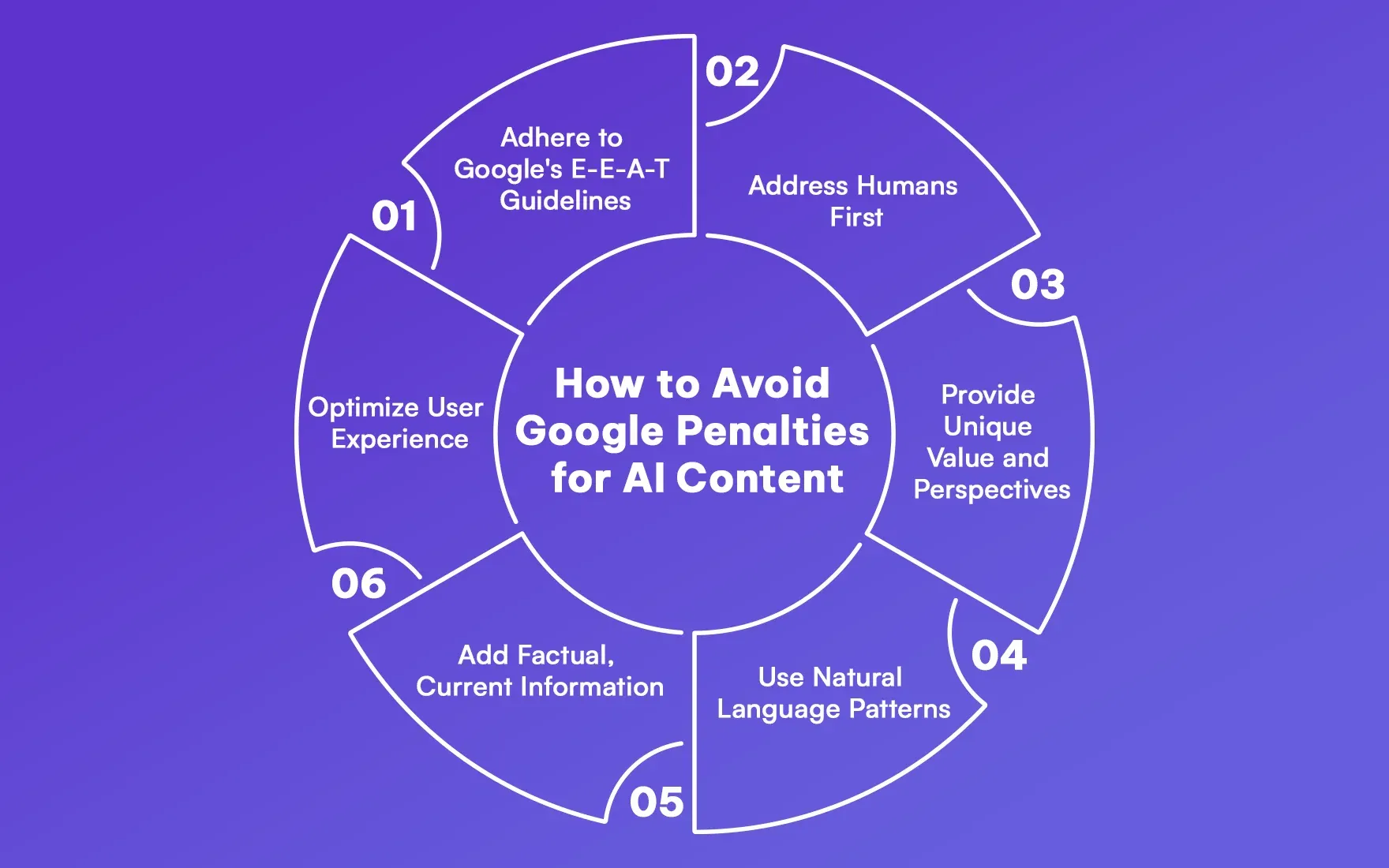
1. Adhere to Google's E-E-A-T Guidelines
Google bases its evaluation of content on Experience, Expertise, Authoritativeness, and Trustworthiness. That can involve discussing your own experiences relating to the topic, highlighting your expertise and knowledge and skills, and demonstrating credible sources and data, along with writing with honesty and transparency. These pillars are central to the Google EEAT guidelines and are critical to ranking success in 2025.
2. Address Humans First
The most important thing to remember is that you must always write for your audience, not search engines. Ask yourself these questions: Does this content help my readers solve a problem? If I were searching for this topic, would I find this article useful? Is it an article providing something I can't find anywhere else? When you prioritize genuinely helping your audience, search engines reward that. This is especially important as Google algorithm updates 2025 are increasingly focused on user intent.
3. Provide Unique Value and Perspectives
Make sure you are not simply rewriting what is already out there. Provide your personal opinions and perspectives, case studies from your experience, original research or data, unique tips and strategies, and true examples and stories. This differentiates valuable content from generic AI text anyone can create.
4. Use Natural Language Patterns
When writing, instead of writing how you normally write, write how you normally speak. You should also use contractions (e.g., don't, can't, won't) and conversational phrases. Use questions to engage the reader, vary your sentence length, use personal pronouns (I, you, we), and generally create a conversational environment—something that is often missing with AI-generated content. This reduces robotic tone that might trigger Google patents AI search 2025 signals.
5. Add Factual, Current Information
Ensure to fact-check your AI content, and add current information. Pull in recent statistics and data, industry trends that are new, current events relating to your topic, or information on updated best practices, and current or new examples and case studies. This shows Google that your content is current and aligns with Google EEAT guidelines.
6. Optimize User Experience
Making your content easy to read and comprehend is of the utmost benefit. A reader should be able to read your content, look at relevant images, and not wait for your content to load. Users are more likely to stay on your site and engage if it's a positive experience reading your article. If users are there longer and engaging with your article, this is a positive indication for search engines that your content is quality content.
Best Practices for Humanizing AI Content
Here are a few best practices to make sure your AI content seems as authentic and engaging as possible:
1. Add a Human Touch
Start by reviewing the text that has been generated by the AI. As you do this, you should read the output out loud to ensure it doesn't happen to be read robotically or awkwardly. You should then adapt sentences to improve the flow and tone. Adding personal stories, conversational and familiar language, or relatable examples can help you relate to your audience on a higher level.
2. Improving Readability
The next step is to break down a few overly long paragraphs and/or sentences. Being too long will act against readability. Next, under each heading, you should utilize subheadings, bullet points, and lists where appropriate. Make sure the information is organized and not overwhelmed by jargon and difficult vocabulary. The easier your content is to read, the more people will engage with it.
3. Maximizing SEO
You've addressed how to humanize your content, but don't forget about SEO. Make sure to add in relevant keywords throughout the text in a natural way. Also make sure to optimize the headings, meta descriptions, and alt tags. You may also incorporate SEO tools that help analyze the content, and make adjustments to visibility. As Google algorithm updates 2025 evolve, proper SEO alongside humanized content becomes a key success factor.
Fact-Check and Cite Sources
AI may generate information that sounds convincing but isn't always accurate. Always fact-check the content and verify the information provided. If you reference studies, statistics, or expert opinions, include proper citations. This adds credibility and aligns your content with Google EEAT guidelines. It also helps when Google patents AI search 2025 emphasize trustworthy data and transparent sourcing.
By following these best practices, you can create AI content that feels genuine, engages readers, and meets Google's quality expectations.
Tools and Services to Help Humanize AI Content
Here are useful tools to help you create better, more human-like content.
1. AI Checker Pro
AI Checker Pro is a powerful tool designed to accurately detect AI-generated content and help writers make their text more human-like, perfect for freelancers and marketers who want to ensure authenticity.
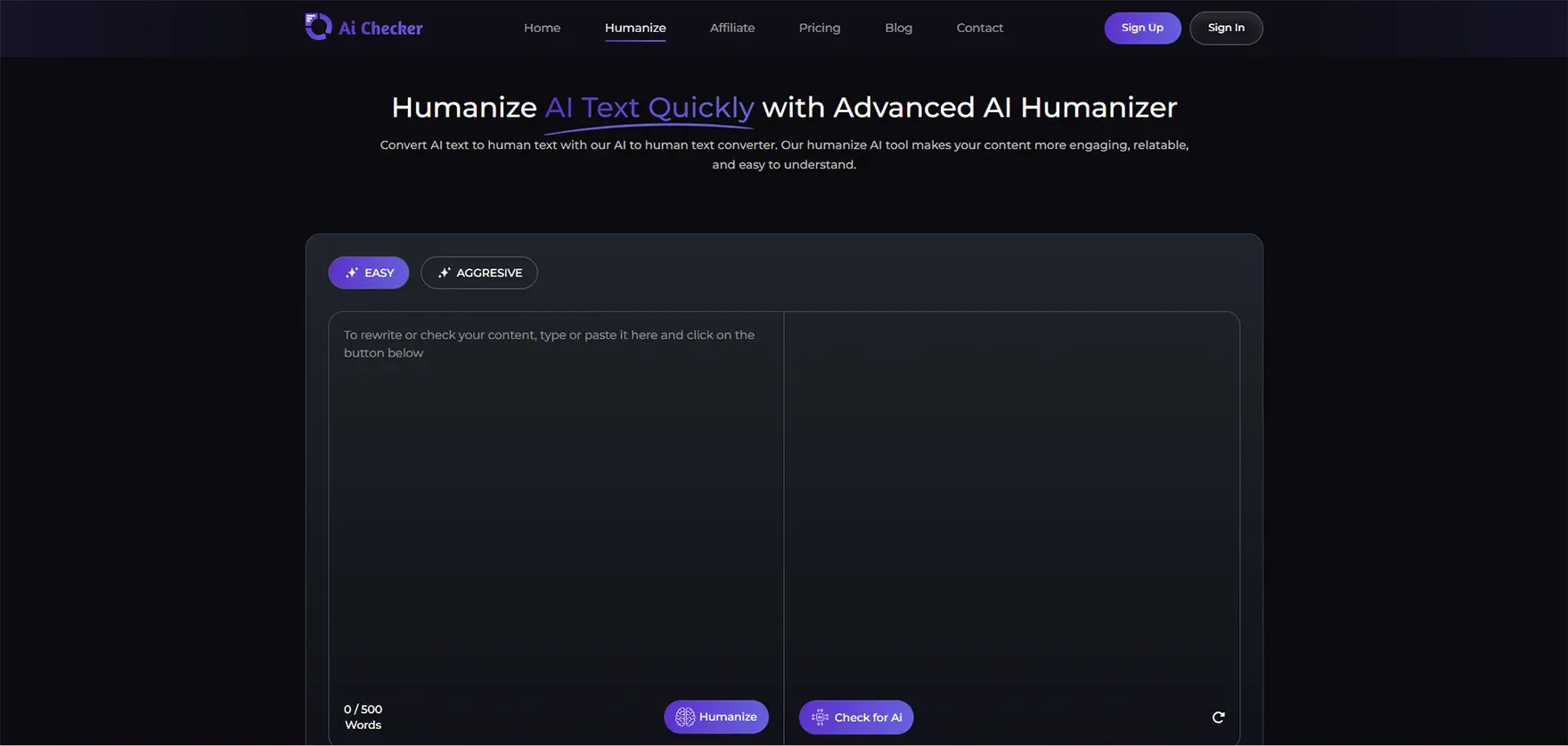
2. AssignmentGPT AI
AssignmentGPT AI offers a flexible solution for rewriting and humanizing AI content, making it a favorite choice among students and professionals looking to avoid detection while maintaining high quality.
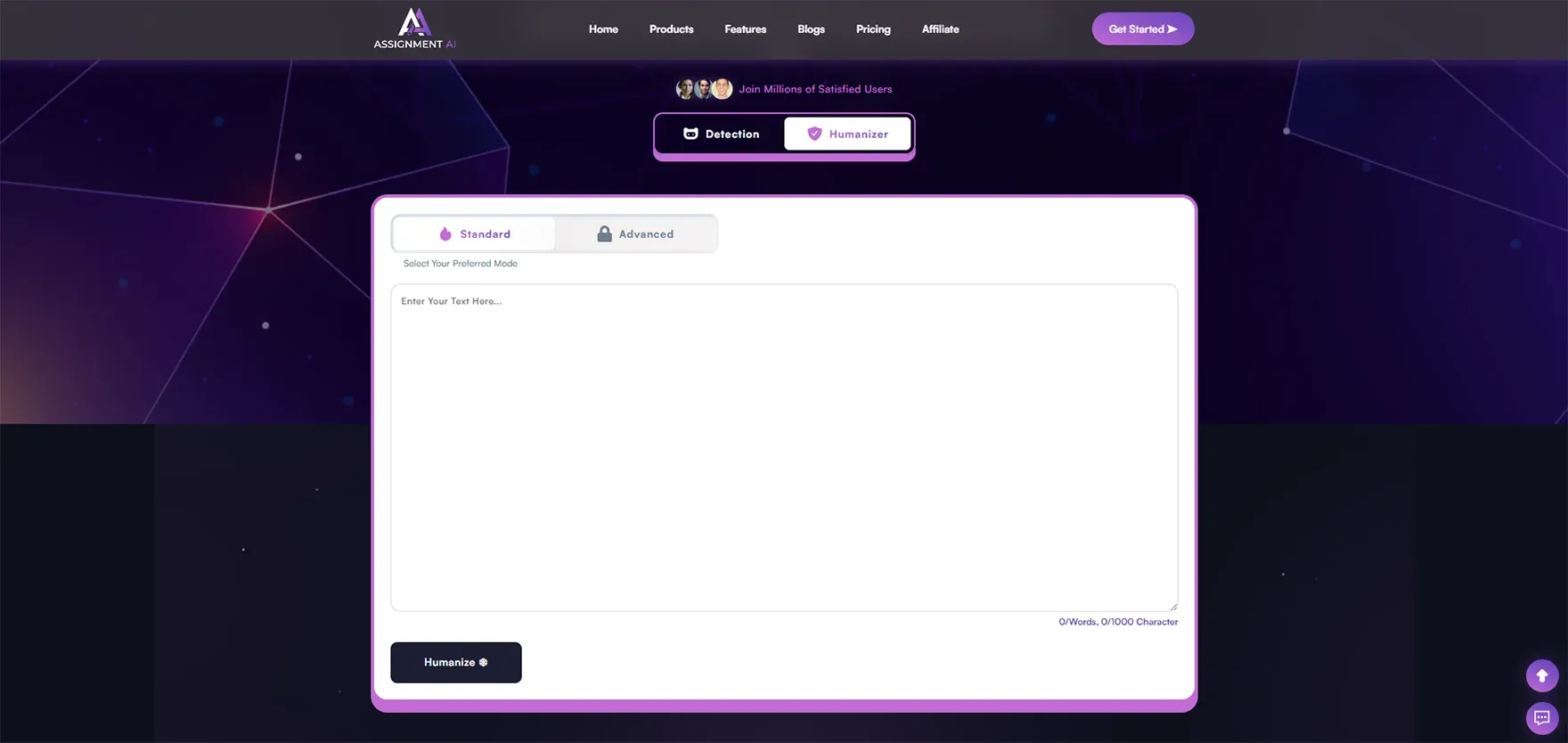
3. Bypass AI
Bypass AIspecializes in transforming robotic AI text into smooth, natural-sounding writing, helping creators pass AI detectors and connect better with human audiences.

4. ZeroGPT
ZeroGPT is a widely used AI detection tool that also offers rewriting features, empowering writers to identify and fix AI signals for more organic, reader-friendly content.
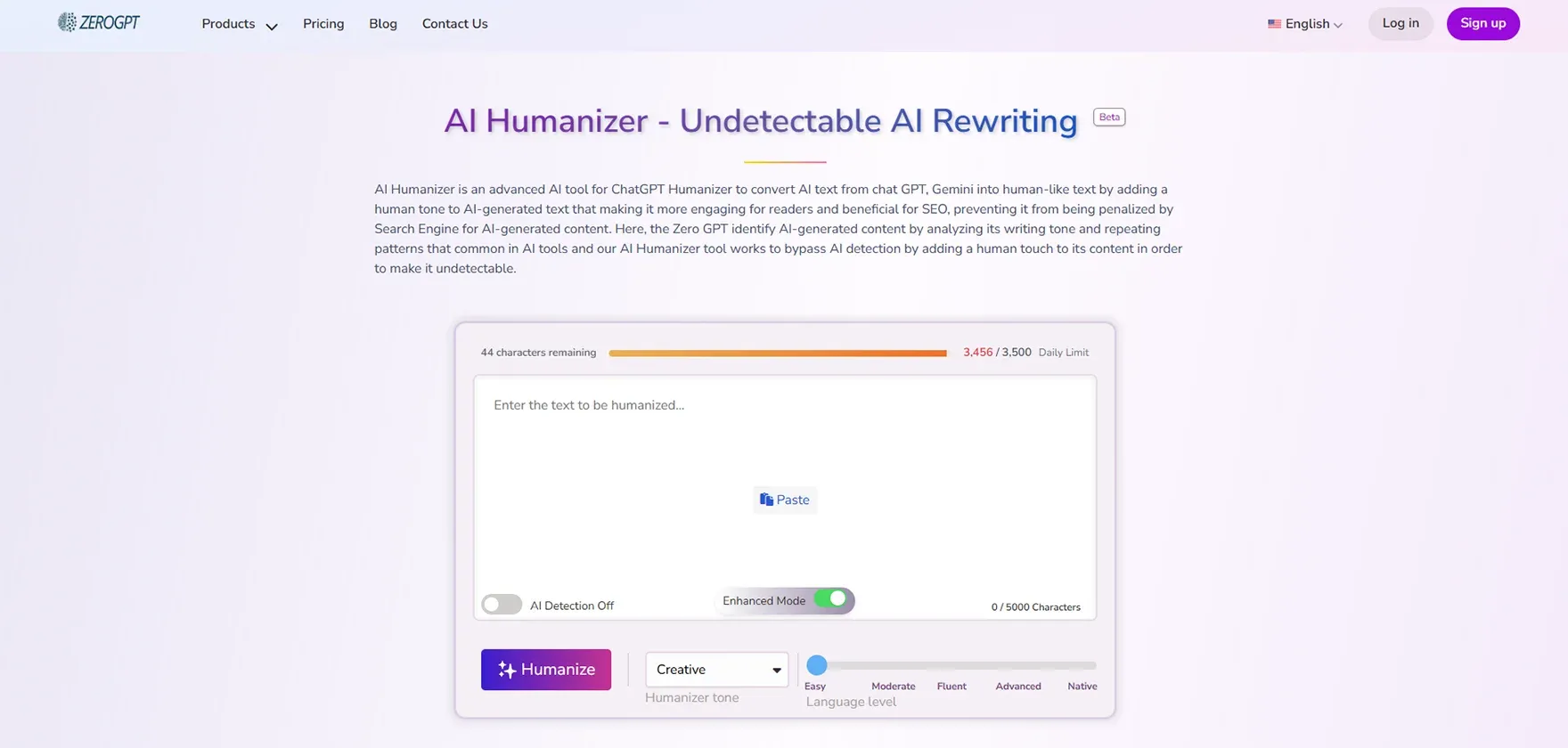
5. QuillBot
Quill Bot is a versatile paraphrasing tool that helps you refine and humanize AI-generated content, making it flow naturally and improving overall readability.
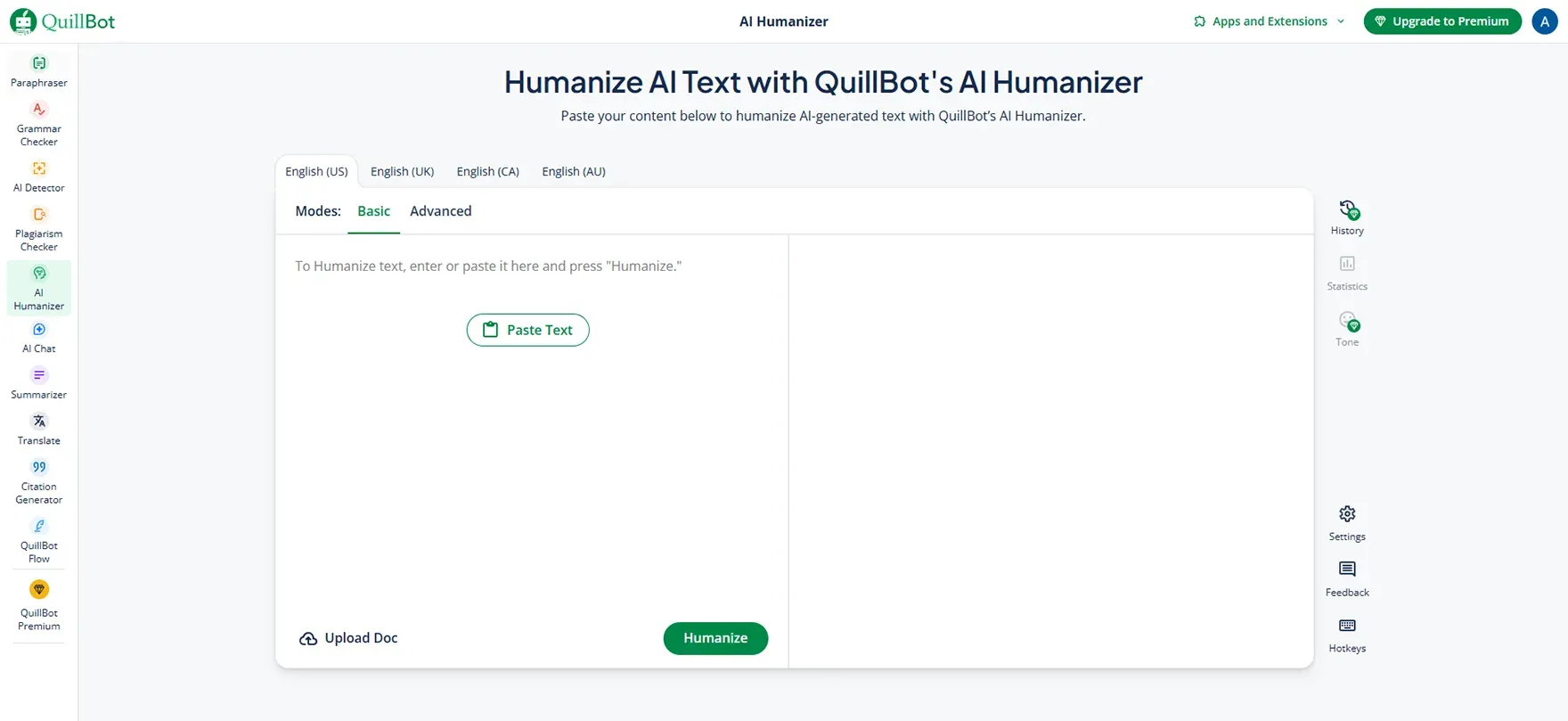
Case Study: AI Content Penalty & Recovery
1. Background
A digital marketing course website relied on AI for the bulk of its blog content. They published thousands of words of content; however, user engagement was low, and Google organic ranking placements were slipping. The site was flagged for low-quality content, which required an objectionable step.
2. Challenge
The primary frustration was the robotic nature of the content. Although the information was accurate and correct, no one would want to sit down and read it, especially if it is related to something they were planning to spend money on. Users spent minimal time on the site, and there was an extensive range of rates. The site was flagged, and the publisher was slapped with penalties for low-quality content.
3. Solution
The team took time to humanize their AI-generated content, relating personal experiences or stories, using simple language, and real-world examples. The team also submitted the content through AI Checker Pro to locate sections that appeared robotic and to paraphrase any awkward sentences/phrases. They also used a human editor who reviewed the tone and quality of the content.
Results
The results were rather astounding. The site achieved user engagement increases, astoundingly low bounce rates compared from when it was AI-generated, and the Google algorithm penalties were lifted. Since the site's credibility and authority increased, they experienced a noticeable bump in organic traffic. Essentially, humanizing the AI-generated content not only resulted in a better user experience but also enabled the content to comply with Google algorithm updates 2025 and remain future-proof.
Final Checklist: Before Publishing Your AI-Generated Content
1. Quality Review
Please review your content for clarity, coherence, and quality. Check to see what meets your brand standards and what is best for the user.
2. Add a Human Element
Add personal stories, personal perspectives, and personal opinions. Humanize the content so it is relatable to the user, and add some engagement.
3. Use AI Checkers
Use AI checkers for non-human phrases, as well as suggestions for improved wording in the content.
4. Paraphrase Tight and Awkward Sentences
For any tight and repetitive sentences, use paraphrasing checkers to rephrase those sentences so they can be read more easily.
5. Human Editor Review
A human editor should review the content one last time to check for tone consistency and quality overall.
Conclusion
In conclusion, AI content can be a great productivity tool, but it can also create serious hazards if it isn't humanized. By humanizing AI content, you ensure it's human-sounding, trustworthy, and valuable to your readers — shielding your site from Google penalties while increasing your trust with your audience. There are many simple ways to humanize AI content — personal stories, readability, quality, and much more. This holistic approach will help you not only avoid algorithm updates but also improve the user experience as a whole. The real goal is to create content that resonates with readers on an emotional level and sticks, while also keeping your rankings safe and strong.
When it comes to humanizing AI-generated content, AIChecker.Pro is a total game changer. Used by bloggers, marketers, and agencies alike, AI Checker Pro helps you find robotic phrasing, adjust the tone, and make your content feel 100% human. Its in-depth analysis and rewriting suggestions make it easy to pump out nothing but engaging, human-sounding content from raw AI text, that your readers and Google will love. If you take algorithm updates seriously and want to build real authority online, AI Checker pro is one of the best tools for your toolbox while developing content.
FAQs
1. What is AI-generated content?
AI-generated content is text, images, or media created by artificial intelligence tools like ChatGPT or Jasper, often lacking human emotion and depth.
2. Can Google detect AI content?
Yes, Google increasingly detects AI-generated content using advanced algorithms and may penalize sites for low-quality or purely AI-generated text.
3. Why should I humanize AI content?
Humanizing makes content natural, engaging, and unique, improving SEO, boosting trust with readers, and avoiding Google algorithm penalties.
4. How do I humanize AI content effectively?
Add personal stories, unique insights, conversational language, fact-check information, and optimize for readability to make it sound truly human.
5. What are the risks of using unedited AI content?
You risk Google penalties, drastic drops in organic traffic, loss of revenue, reduced user trust, and long-term damage to your brand reputation.
6. What is E-E-A-T in Google guidelines?
E-E-A-T stands for Experience, Expertise, Authoritativeness, and Trustworthiness — all essential to rank and avoid penalties in Google search.
7. How can AI Checker Pro help?
AI Checker Pro detects robotic phrases and suggests improvements to make your content sound natural, helping you comply with Google updates and improve quality.

Nathan Porter
Content writer at @Aichecker
I am a content writer at AI Checker Pro, where I craft engaging, SEO-optimized content to enhance brand visibility and educate users about our AI-driven solutions. My role involves creating clear, impactful messaging across digital platforms to drive engagement and support company growth.


